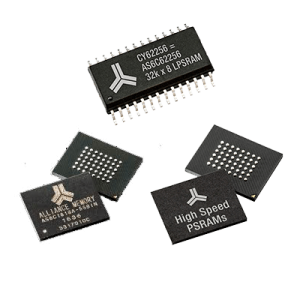
SRAM (Static Random-Access Memory) ICs ( Integrated Circuits) are semiconductor devices designed for high-speed data storage and retrieval. Unlike DRAM (Dynamic RAM), SRAM retains data without periodic refresh cycles, making it ideal for applications requiring low latency and deterministic performance. This guide explores SRAM ICs’ technical foundations, use cases, and industry trends.
Table of Contents
ToggleHow SRAM ICs Work
Core Architecture
- 6-Transistor (6T) Cell: Each SRAM bit uses six MOSFETs arranged as cross-coupled inverters (two for storage, four for access control).
- Data Retention: Latches maintain state indefinitely with stable power VDD>VminVDD>Vmin, eliminating refresh cycles.
Operational Modes
- Read Operation
Word line activates access transistors → Differential voltage sensed on bit lines. - Write Operation
Bit lines driven to override cell state via strong write drivers.
Power Consumption
- Active Current: ~10–50 mA (during read/write).
- Standby Current: ~1–5 µA (data retention only).
SRAM vs DRAM: Key Differences
| Feature | SRAM | DRAM |
|---|---|---|
| Cell Structure | 6 transistors | 1 transistor + 1 capacitor |
| Refresh Required | No | Yes (every ~64 ms) |
| Speed | ~1–10 ns access time | ~30–100 ns access time |
| Density | Lower (due to complex cells) | Higher (simpler cells) |
| Cost | Higher ($$$) | Lower ($) |
| Use Case | Cache, registers | Main memory |
Types of SRAM ICs
- Asynchronous SRAM
- Operates without a clock signal.
- Used in legacy systems and low-speed embedded devices.
- Synchronous SRAM (SyncBurst, ZBT)
- Clock-aligned operations for pipelining.
- Common in networking hardware (e.g., routers).
- Quad Data Rate (QDR) SRAM
- Separate read/write ports for simultaneous access.
- Bandwidth: Up to 576 Gbps (e.g., QDR-IV).
- Low-Power SRAM
- Subthreshold designs for IoT devices.
- Standby power: <1 µW.
Applications of SRAM
- CPU Cache Memory
- L1/L2/L3 caches in processors (e.g., Intel/AMD CPUs use SRAM for <10 ns latency).
- Networking Equipment
- Packet buffering in switches/routers (Cisco ASICs leverage SyncBurst SRAM).
- Automotive Systems
- ADAS (Advanced Driver Assistance Systems) rely on radiation-hardened SRAM for reliability.
- Aerospace & Defense
- Radiation-tolerant SRAM in satellites (e.g., SpaceX Starlink modules).
- FPGA Configuration Storage
- Non-volatile SRAM (nvSRAM) holds FPGA states during power loss.
Advantages and Limitations
✅ Pros
- Zero Refresh Overhead: Ideal for real-time systems.
- Speed: 10x faster than DRAM in access time.
- Predictable Timing: Critical for hardware accelerators.
❌ Cons
- Cost: 6T cells limit density (e.g., 1 MB SRAM ≈ 120 mm² at 7 nm).
- Volatility: Requires backup power for data retention.
Future Trends
- 3D Stacking: TSV (Through-Silicon Via) integration to boost density.
- Alternative SRAM Designs
- 4T (4-Transistor) cells with resistive load for lower area.
- Neuromorphic Computing
- SRAM-based analog compute-in-memory for AI edge devices.
- Cryogenic SRAM
- Operation at 4K for quantum computing control systems.
Conclusion
SRAM ICs remain indispensable in high-performance computing, automotive, and communication systems despite competition from emerging memories like MRAM. Advances in process scaling (e.g., 3 nm FinFET) and novel architectures will ensure their relevance in next-gen hardware. For applications demanding speed and deterministic behavior, SRAM is irreplaceable.
- Everything You Need To Know About Limit Switch - May 21, 2025
- Everthing You Should Know About Rheostat - May 20, 2025
- Everything You Need To Know About Reversing Contactor - May 19, 2025






